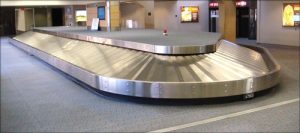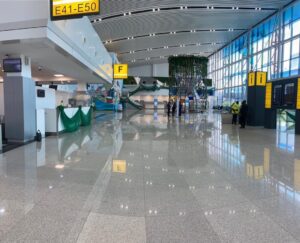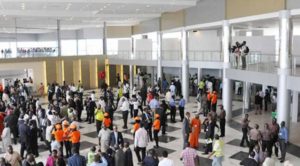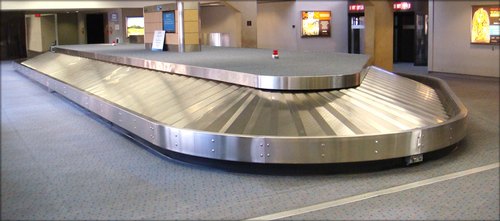
Nigerian domestic carriers are set to bring in new aircraft, increase their fleet, but the challenge they face is that airport facilities are not expanding to accommodate more aircraft and increase in passenger traffic. The report notes that inadequate and obsolete airport infrastructure could retard growth of the aviation sector
Recently, travel expert and the organiser of Akwaaba African Market, Ikechi Uko, said facilities at Nigerian airports may not be able to accommodate the new equipment being brought into the airport.
He said this while reacting to the report on the delivery of brand new aircraft by three Nigerian airlines: Air Peace, Ibom Air and Overland airways in the next 36 months.
THISDAY had last week exclusively reported that Air Peace, beyond the 10 brand new Embraer E195-E2 expected to be delivered this year, is expecting 15 Boeing 737MAX 8 and MAX 10 to be delivered in the same three-year timeline.
Industry stakeholders posited that greater priority in the Aviation Master Plan of the President Muhammadu Buhari’s administration should have been modernizing the airports, establishing Maintenance, Repair and Overhaul (MRO) facility and establishing a leasing company, instead of a national carrier and the establishment of aerospace university, as Nigeria has well reputed aviation college, the Nigeria College of Aviation Technology (NCAT), Zaria and the International Aviation College, Ilorin. Also, domestic airlines still provide Nigerian travellers the needed capacity for domestic, regional and international travel so the country is not in dire need of a national carrier as it would airports with modern facilities, MRO and leasing company.
Planning
Top airline official and former airport manager both in Nigeria and overseas has made significant observation about building airports and terminals in the country and urged that Nigeria should let go arbitrariness and spontaneous decision making on critical issues concerning airport development.
He said processes should be followed and everything about airport development should be planned and such plans should strictly be followed.
According to him, airports must meet certain standards in tandem with their categories and there is need for continuous upgrade of airport infrastructure to dovetail with current growth of the aviation sector.
“Part of the certification of an airport is that its infrastructure is designed in accordance with the regulations. So apron capacity, apron strength, apron dimensions, markings, procedures, lighting, signage, parking bays, taxi lanes, etc must be compliant. After the NCAA (the Nigerian Civil Aviation Authority) approves that, it is the airport that must regulate its own capacity, by ensuring that operations are in line with its certification. If you have capacity to process 10 flights an hour and you accept 11 or more flights an hour, you’re creating a serious safety hazard, not to mention huge negative service implications for all airport users. He said airports must cap their peaks to suit their capacity and force customers to spread their schedules, when capacity is maxed out at certain slots.

“Are we doing this yet? Obviously not. It’s a potentially unsafe situation in Lagos (both GAT and MM2 (the domestic terminals) and Abuja for many hours every day. You can see that just by observing the operations, if you know what to look for (and for operators, we feel the huge impact of this on our businesses),” he said.
He frowned at the fact that Nigeria does not develop its airports on the basis of master plan and that is why airport development has not kept pace with growth of the industry, including passenger growth, airline growth and emergence of new aircraft fleet.
“On the other hand, we are where we are because we do not develop our airports on the basis of master plans. As a result, we have not catered for this growth as a system. Airport infrastructure is planned with capacity to match, from road access and egress, to terminal throughput, to apron parking and runway/taxiway capacity. It’s an end-to-end thing. But as long as someone says, ‘let’s build a terminal here’, with no attention to the basics, you get what we have. The first question a terminal designer requires answered is, ‘how many passengers are we designing for’? When that is answered, then everything from end to end must be made to match; otherwise you get capacity mismatch and resultant gridlock, not to mention latent unsafe conditions. The best approach to this is to have a well thought out master plan for the airport,” the industry expert said.
Retarding Growth
He also noted that it is the airport’s primary business interest to anticipate traffic growth and to develop its infrastructure to match that anticipated growth ‘just in time’ for it. If not, then the airport itself becomes the obstacle to its own growth and negatively affects economic growth in its catchment area.
He regretted that many terrible decisions have been made in the aviation industry and even some of them bordering on criminal and the country has been suffering the consequences of these poor decisions for years now.
“One major credit that we have not given this current Minister is the quiet but thorough and painstaking effort he has made to mitigate the grave and extremely costly mistakes made by his predecessors. And he has done this without casting blame. It is sad to note that Nigeria, our country, built manifestly ‘silly’ terminals for billions of Naira and then had to spend further billions of Naira to try to correct them and make them even basically workable,” he also observed.
He said that after making structural and other corrections of the various grave mistakes made, apron capacity for both passengers and cargo should now be expanded.
“Master plans need to be done for the airports and codified. Nobody should come and say, ‘build am here’. ‘Put am there’. Airports cannot be developed like that. If we continue on this trajectory, we cannot build an Ethiopian-like airline here. This thing cannot be wished into existence. The right work has to be done to move our industry into the 21st century. This is 2023, my friends. Nigeria deserves much better,” he stated.
THISDAY checks revealed that apron of many Nigerian airports seem to pay the price of bad planning and bad design, as the apron of the airports cannot take in many number of aircraft that provide service to the passengers, even at the busiest airports in Lagos and Abuja. At the General Aviation Terminal (GAT) in Lagos, the apron is too small to accommodate operating aircraft and that is why there has been high record of aircraft collision.
At the MMA2 the apron is also small that sometimes during peak hours passengers are bussed from the GAT, as the aircraft cannot be accommodated at the apron of the terminal.
In October last year when passenger traffic started building up at the Nnamdi Azikiwe International Airport, Abuja, sometimes aircraft that has landed would have to keep passengers in and wait at the taxiway for aircraft already boarded to create space as it taxies of the apron for the arriving aircraft to take over. Sometimes it could cause up to 25 minutes delay.

Reviewing Past Airport Plans
Industry expert and Executive Secretary of Aviation Round Table (ART), Group Captain John Ojikutu, urged that there should be a review to current regulations because currently, many airlines seem to be operating from two major airports, Lagos and Abuja airports and that is why the domestic terminals of the two airports are congested.
“We need to go back to the FCAA (Federal Civil Aviation Authority) Operational Directives of the early 1990s; all the operating airlines should have operational bases and not concentrating in only Lagos; Kabo had its base in Kano, Okada in Benin, Triax in Enugu, Barnex in PH, etc; however, ADC that was expected to be operating from Calabar broke the rule because of the relationship the management had then with those in the administration of the government. Unfortunately, those ones could not save it from the reports of the two crashes in Ejinrin and Abuja,” Ojikutu said.
He remarked that the allocation of operational bases for them was to create spaces at the Lagos airport aprons where they all were concentrated, recalling that the number of aircraft then in the operating airlines were not together up to fifty except the okada with about 15 in its fleet, adding that Lagos was specially meant for the Nigeria Airways.
“Today, even with the increase and expansion of terminals aprons, airlines are demanding for space for their aircraft because they are all concentrated in Lagos. In spite of the concentrations, no regulations is in place by the airport terminals operators and the regulatory authority on how many aircraft can be accommodated on the aprons neither are the aprons marked out for the number. No specific number of ground handling services equipment is provided in terminals operating manuals and that includes the fuel dispenser for the aircraft.
“There were fuel hydrants in all aprons where fuel dispensing engines tap into to supply fuel to aircrafts; today fuel tankers are the common dispenser of fuel into the aircrafts. Nobody has looked into the dangerous manner the drivers that are not certified get into the aviation operating environment. It is not sufficient that the drivers hold a driving licence; they must be certified in safely operations in the aviation environment. This is one major reason why there had been many collisions on the Lagos aprons where there is uncontrolled number of aircraft on the aprons. That is the responsibility of the NCAA to oversight whether or not the terminal operator has failed to specify that in its operations manuals,” he said.
Night Operations
The Managing Director of Flight and Logistics Solutions Limited, Amos Akpan, told THISDAY that while it is very important to have airfield lighting in many airports where airlines operate till night, but it is not all the airports that must have night landing facilities. But currently, few airports have night lighting facilities; that an aircraft in the Nigerian airspace would have few airports to land in under emergency. With 32 airports, 26 operated by the Federal Airports Authority of Nigeria (FAAN), Nigeria does not have more than seven airports with guaranteed landing aids in the night. Some of the airports like the Uyo; Enugu and Anambra airports, night landing is allowed on request. It is expected that some of these airports have permanent landing lighting and other aids. But Akpan insisted that not all airports should have landing aids.
“Airports are designed and equipped with infrastructure to meet specific functions. That is why we have them in categories and give them nomenclatures like tourism airport, agro cargo airport, transit/hub airport, maintenance airport etc. Every airport issue Notice To Airmen (NOTAM), in addition to ICAO/IATA published compilation – JEPPERSON.
“A thorough feasibility study for most of the airports will reveal non sustainable traffic data (in and out) from number of flights/aircraft to passengers and cargo. The other business activities within the airport that should attract traffic are undeveloped, or nonviable due to economies in their location,” he said.
Akpan observed that airports world wide offer services within their infrastructural capacities; and they mandatorily publish their range of services including their limits like currently available status of the aeronautical services, runway, fuel, handling equipment and allied services.

“I won’t advise any airport management to start offering services that the economy of the target markets in the environment will not enhance its sustainability. By illustration, AkwaIbom State airport could only offer services between 6am to 6pm daily. Arik Air, Dana Air, Air Peace were operating into that airport. Ibom Air came with increased schedule to destinations beyond Lagos and Abuja. Ibom Airport had to extend its closure time on request to 10pm and sometimes to 11pm for Ibom Air to land (not everyday). Currently other airlines are not flying into Ibom Airport again because it is no longer economically viable for them since Ibom Air offers, ‘fit to market size capacity’” he added.
He also said that Nigeria should focus on securing the airport cities, provision of electric power to light the environment and to power businesses and create enabling environment for allied businesses to operate around the airport cities, noting that there must be attractions to fly into or through the airport for the airlines, the passengers, and the cargo.






